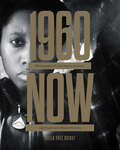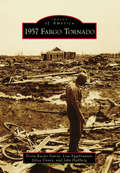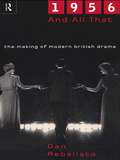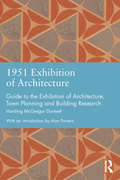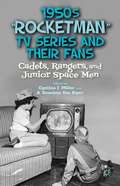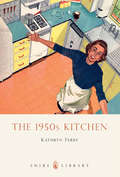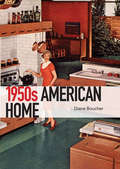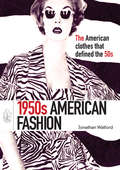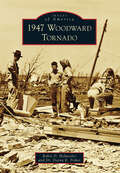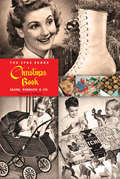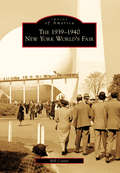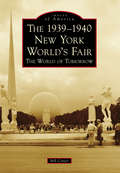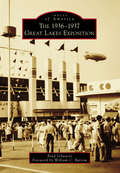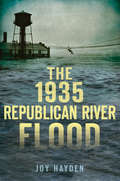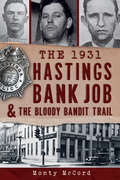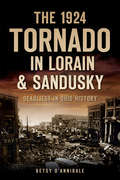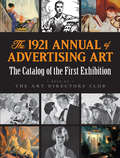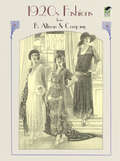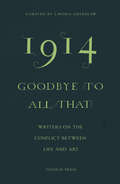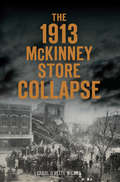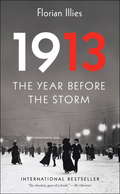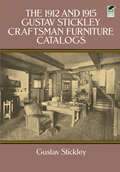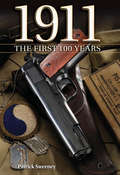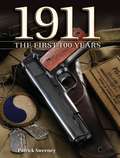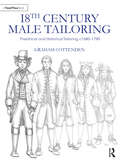- Table View
- List View
#1960Now: Photographs of Civil Rights Activists and Black Lives Matter Protests
by Alicia Garza Sheila Pree BrightThe fight for equality continues, from 1960 to now. Combining portraits of past and present social justice activists with documentary images from recent protests throughout the United States, #1960Now sheds light on the parallels between the 1960s Civil Rights Movement and the Black Lives Matter movement of today. Shelia Pree Bright's striking black-and-white photographs capture the courage and conviction of '60s elder statesmen and a new generation of activists, offering a powerful reminder that the fight for justice is far from over. #1960Now represents an important new contribution to American protest photography.
1957 Fargo Tornado (Images of America)
by Trista Raezer-Stursa Lisa Eggebraaten Jylisa Doney John HallbergOn the evening of June 20, 1957, a tornado ripped through Fargo, North Dakota. It caused the deaths of seven children and five adults and left 116 injured. The tornado destroyed 359 buildings and damaged 2,543 more. The nine-mile path of destruction covered over 66 blocks in town, leaving more than 2,000 people homeless and causing approximately $20 million worth of damage. Following the tornado, first responders quickly united to aid those in need, setting up disaster headquarters, finding shelter for over 600 people, and distributing more than 100 tons of clothing and bedding. Dr. Tetsuya Fujita, a meteorologist, studied the Fargo tornado when creating the Fujita scale (F-scale) and later rated it an F5, the most destructive rating. Images of America: 1957 Fargo Tornado, shines a light on the tornado's destruction and the rebuilding of a united and vibrant community.
1956 and All That: The Making of Modern British Drama
by Dan RebellatoIt is said that British Drama was shockingly lifted out of the doldrums by the 'revolutionary' appearance of John Osborne's Look Back in Anger at the Royal Court in May 1956. But had the theatre been as ephemeral and effeminate as the Angry Young Men claimed? Was the era of Terence Rattigan and 'Binkie' Beaumont as repressed and closeted as it seems? In this bold and fascinating challenge to the received wisdom of the last forty years of theatrical history, Dan Rebellato uncovers a different story altogether. It is one where Britain's declining Empire and increasing panic over the 'problem' of homosexuality played a crucial role in the construction of an enduring myth of the theatre. By going back to primary sources and rigorously questioning all assumptions, Rebellato has rewritten the history of the Making of Modern British Drama.
1951 Exhibition of Architecture: Guide to the Exhibition of Architecture, Town Planning and Building Research (Studies in International Planning History)
by Harding McGregor DunnettThe Festival of Britain is perhaps best known for its South Bank Exhibition promoting British science and art to the post-war world, but one of the most important elements was the Architecture Exhibition, based in Poplar in East London. This exhibition was used to demonstrate the principles of modern town planning that had been laid out by Abercrombie, in particular in his County of London Plan. The project was named after George Lansbury, the Labour MP, London County Council (LCC) member and Poplar councillor. It was an effective demonstration of planning ideas adopted since the 1930s by influential planners, taking the village as a model and retaining the terraced house as a housing option among medium rise flats. Small squares and open spaces were favoured, with paved pedestrian spaces, all at lower than pre-war densities. The guide is revealing of the broader thinking in English planning in the mid century. It provides an opportunity for looking at conflicts among advocates of different planning ideas in the period of reconstruction and the move by architects to regain control of LCC housing from the Valuer’s Department. It offers the model of integrated professional specialisms that was seen as central to Modernism’s mission. It is also an opportunity to describe in more detail the interaction of different professions, including, for example, a sociologist, employed by the LCC in the creation of a model for reconstruction.
1950s "Rocketman" TV Series and Their Fans
by Cynthia J. MillerThe fourteen essays featured here focus on series such as Space Patrol, Tom Corbett, and Captain Z-Ro, exploring their roles in the day-to-day lives of their fans through topics such as mentoring, promotion of the real-world space program, merchandising, gender issues, and ranger clubs - all the while promoting the fledgling medium of television.
The 1950s Kitchen
by Kathryn FerryThe 1950s was the first great age of the modern kitchen: labor-saving appliances, bright colors and the novelty of fitted units moved the kitchen from dankness into light, where it became the domain of the happy housewife and the heart of the home. Formica - a new space-age material - decorated with fashionable patterns topped sleek cupboards that contained new classic wares such as Pyrex and 'Homemaker' crockery, and the ingredients for 1950s British staples: semolina, coronation chicken and spotted dick. Electricity entered the kitchens of millions, and nowhere in the home was modern technology and modern design more evident. Bold color, clean lines and stainless steel were keynotes of the decade, and it is no surprise that 1950s kitchen style is now the height of fashion once again, with names like Cath Kidston picking up on the best of '50s kitchen kitsch, and manufacturers like Dualit, Kitchen Aid and Aga doing healthy business with retro appliances. This book - a celebration of cooking, eating and living in the 1950s kitchen - is a feast of nostalgia, and a mine of inspiration for anyone wanting to recreate that '50s look in their own home.From the Trade Paperback edition.
The 1950s American Home
by Diane BoucherThis title explores what life was like in the 1950s American home. An age of optimism, it is about living the American Dream and how this was achieved, changes in the home, new convenience technology, new ways of living. From Ranch House to American Modernism to affordable homes in the suburbs, this was how to live the good life in an era of unprecedented prosperity and opportunity.From the Trade Paperback edition.
1950s American Fashion
by Jonathan WalfordThe 1950s was the first decade when American fashion became truly American. The United States had always relied on Europe for its style leads, but during World War II, when necessity became the mother of invention, the country had to find its own way. American designers looked to what American women needed and found new inspirations for American fashion design. Sportswear became a strength, but not at the expense of elegance. Easy wear materials were borrowed for producing more formal clothes, and versatile separates and adaptable dress and jacket suits became hallmarks of American style. This book follows the American fashion industry, from New York's 7th Avenue to the beaches of California in search of the clothes that designed 1950s American fashion.
1947 Woodward Tornado (Images of America)
by Robin D. Hohweiler Dr. Deena FisherThe 1947 Woodward Tornado remains the deadliest tornado in Oklahoma history, leaving more than 100 people dead and nearly 1,000 seriously injured. The tornado struck the city of Woodward under cover of darkness and without warning at 8:42 p.m. on April 9, 1947. The storm left in its wake hundreds of stories of tragic loss, devastation, and even mysteries that remain unsolved. These include the three unidentified girls--one as young as six months--whose bodies have remained unclaimed, as well as the mystery of what happened to Joan Gay Croft, a girl who disappeared from the local hospital on the night of the storm. Croft's disappearance was featured in an episode of the television show Unsolved Mysteries in the early 1990s. There is also the oft-overlooked story of those who took up residence (some for more than a year) in "Tornado Town" west of the city and found some glimmer of hope in an otherwise hopeless situation.
The 1942 Sears Christmas Book: Create Your Own Illustrated Winter Wonderland With Tantalizing Scented Markers And Delectable Stickers In One Holiday-filled Activity Book (Sweet Scentsations Ser. #Vol. 4)
by Sears, Roebuck and Co.For generations, the much-anticipated arrival of the Sears gift catalog signaled the start of the holiday season. This faithful facsimile of the retailer's 1942 Christmas edition offers a nostalgia-inducing chance to relive those bygone years, when turning the pages of a catalog could excite young minds with dreams of a shiny toy truck or a new doll under the tree.A unique collectible, The 1942 Sears Christmas Book also provides an interesting look at how merchandise has evolved over the years. In 1942, Sears shoppers could purchase toys as well as housewares, clothes, furniture, candy, and gifts to send to servicemen (all at prices that now seem astonishingly low). The wartime catalog even includes information about the importance of saving scrap metal for munitions and encourages readers to buy war bonds.A new Introduction by Ben B. Judd, Jr., PhD, the former chair of the University of New Haven Department of Marketing and International Business, provides thought-provoking insights into the catalog's importance to rural America and the recent downfall of the retail giant.
1939-1940 New York World's Fair, The
by Bill CotterAfter enduring 10 harrowing years of the Great Depression, visitors to the 1939-1940 New York World's Fair found welcome relief in the fair's optimistic presentation of the "World of Tomorrow." Pavilions from America's largest corporations and dozens of countries were spread across a 1,216-acre site, showcasing the latest industrial marvels and predictions for the future intermingled with cultural displays from around the world. Well known for its theme structures, the Trylon and Perisphere, the fair was an intriguing mixture of technology, science, architecture, showmanship, and politics. Proclaimed by many as the most memorable world's fair ever held, it predicted wonderful times were ahead for the world even as the clouds of war were gathering. Through vintage photographs, most never published before, The 1939-1940 New York World's Fair recaptures those days when the eyes of the world were on New York and on the future.
The 1939-1940 New York World's Fair: The World of Tomorrow (Images of America)
by Bill CotterThe World of Tomorrow
The 1936-1937 Great Lakes Exposition (Images of America)
by Brad Schwartz William C. BarrowThe Great Lakes Exposition was held in Cleveland during the summers of 1936 and 1937, drawing seven million visitors over its two-year run. The exposition was intended to observe the city's centennial anniversary and to celebrate the Great Lakes Region. It was also hoped that it would help lift the city's economy out of the Great Depression. The exposition boasted a staggering array of ever-changing national-level attractions and feature events. In a single day, exposition visitors could experience the latest technological innovations; see a world-class aquatics show; watch a Shakespearean play; ride in a blimp; and hear the music, taste the food, view the architecture, and experience the culture of 40 of the world's countries.
The 1935 Republican River Flood (Disaster)
by Joy HaydenOn May 31, 1935, a storm system surged along the Republican River, bursting its banks in a matter of minutes with a roar that could be heard miles away. The greatest flood to hit the tri-state area of Colorado, Kansas and Nebraska, it left behind a landscape rearranged beyond recognition and claimed more than one hundred casualties. However, amid all the destruction and sorrow, amazing acts of heroism and unwavering courage were reported throughout the valley. Author Joy Hayden reveals the historic disaster and the steadfast resolve of those who witnessed it.
The 1931 Hastings Bank Job & the Bloody Bandit Trail
by Monty MccordIn February 1931, "Mr. & Mrs. Robert Hendricks" and three others tied up fourteen employees at the Hastings National Bank and walked away with over $27,000 from the vault. They then returned home to plan a robbery of the First National Bank for the following day. Even though police quickly surrounded the house, the robbers managed to capture all eleven officers on the scene and make a getaway. Retired police lieutenant and historian Monty McCord recounts the crime and the grisly aftermath in the first account of the heist ever to be published.
The 1924 Tornado in Lorain & Sandusky: Deadliest In Ohio History (Disaster)
by Betsy D'AnnibaleJune 28, 1924, dawned hot and sunny, with fluffy white clouds hovering over a blue and inviting Lake Erie. For two Ohio communities, Lorain and Sandusky, the day ended in unimaginable disaster. In the late afternoon, the blue sky turned dark, and the wispy white puffs morphed into a mass of black thunderclouds as a monster formed on the lake. An F4 tornado, unexpected and not understood, was born from a thunderstorm on the now turbulent waters of Lake Erie. It charged ashore, smashing into Sandusky, retreated again to the lake and then headed east before turning abruptly south to make landfall in Lorain. Before the massive funnel lifted, it would destroy a city, create death records still unbroken and change the lives of thousands of people.
The 1921 Annual of Advertising Art: The Catalog of the First Exhibition Held by The Art Directors Club
by Art Directors ClubThe publishing boom of the early twentieth century led to an entirely new vocation, that of art direction for editorial publications and advertising. In 1921, the recently formed Art Directors Club resolved to show that their profession involved more than just signage for selling products. Their exhibition of paintings and drawings, intended to prove their work worthy of artistic consideration, was judged by a jury that featured some of the era's most distinguished names in illustration and art, including Ashcan School painter Robert Henri; Charles Dana Gibson, creator of the "Gibson Girl"; and outstanding New York artist Joseph Pennell, among others. This reproduction of the exhibition's catalog offers a generous selection of more than 300 halftone images, accompanied by an appendix of the ads' corresponding sources. New to this edition are added pages of brilliant color reproductions of a selection of the best materials. Entries by leaders in the field include J. C. Leyendecker's ads for Arrow shirts, Maxfield Parrish's Mazda Lamp calendar pages, Franklin Booth's line art, and contributions by Norman Rockwell, Edward Penfield, N. C. Wyeth, and other luminaries. Students of art, illustration, and advertising as well as professional illustrators, historians, and anyone with an appreciation of advertising art will find this volume a richly evocative source of historic commercial art.
1920s Fashions from B. Altman & Company
by Altman Co.Over 700 black-and-white illustrations, detailed descriptions, and prices for a vast array of upscale women's clothing and accessories appear among these highlights from rare 1920s B. Altman & Company catalogs. Stylized drawings of flappers depict sophisticated dresses, bathing suits, cloche hats, shoes, and more. A selection of attire for men and children is included.
1914 - Goodbye to All That
by Jeanette Winterson Elif Shafak Erwin Mortier Colm Toibin Lawinia GreenlawIn this collection of essays, ten leading writers from different countries consider the conflicts that have informed their own literary lives. 1914-Goodbye to All That borrows its title from Robert Graves's "bitter leave-taking of England" in which he writes not only of the First World War but the questions it raised: how to live, how to live with each other, and how to write. Interpreting this title as broadly and ambiguously as Graves intended, these essays mark the War's centenary by reinvigorating these questions. The book includes Elif Shafak on an inheritance of silence in Turkey, Ali Smith on lost voices in Scotland, Xiaolu Guo on the 100,000 Chinese sent to the Front, Daniel Kehlmann on hypnotism in Berlin, Colm Toibin on Lady Gregory losing her son fighting for Britain as she fought for an independent Ireland, Kamila Shamsie on reimagining Karachi, Erwin Mortier on occupied Belgium's legacy of shame, NoViolet Bulawayo on Zimbabwe and clarity, Ales Steger on resisting history in Slovenia, and Jeanette Winterson on what art is for. Contributors include: Ali Smith - Scotland Ales Steger - Slovenia Jeanette Winterson - England Elif Shafak - Turkey NoViolet Bulawayo - Zimbabwe Colm Toíbín - Ireland Xiaolu Guo - China Erwin Mortier - Belgium Kamila Shamsie - Pakistan Daniel Kehlmann - GermanyFrom the Trade Paperback edition.
The 1913 McKinney Store Collapse (Disaster)
by Carol O'Keefe WilsonA powerful vibration, a deafening noise and a swell of thick dust brought residents of McKinney pouring into the public square on the afternoon of January 23, 1913. What they saw was horrifying--an entire building had collapsed, demolishing two popular retailers, the Cheeves Mississippi Store and Tingle Implement Store. Their contents, including many shoppers and clerks, spilled out into the streets, where layer upon layer of debris settled into a massive, ragged pile. In spite of a herculean rescue effort, eight people perished. Carol Wilson sifts through the disaster and its aftermath, dredging up some troubling facts about how the tragedy might have been prevented.
1913
by Shaun Whiteside Florian Illies Jamie Lee SearleJust before one of its darkest moments came the twentieth century's most exciting year . . .It was the year Henry Ford first put a conveyer belt in his car factory, and the year Louis Armstrong first picked up a trumpet. It was the year Charlie Chaplin signed his first movie contract, and Coco Chanel and Prada opened their first dress shops. It was the year Proust began his opus, Stravinsky wrote The Rite of Spring, and the first Armory Show in New York introduced the world to Picasso and the world of abstract art. It was the year the recreational drug now known as ecstasy was invented.It was 1913, the year before the world plunged into the catastrophic darkness of World War I.In a witty yet moving narrative that progresses month by month through the year, and is interspersed with numerous photos and documentary artifacts (such as Kafka's love letters), Florian Illies ignores the conventions of the stodgy tome so common in "one year" histories. Forefronting cultural matters as much as politics, he delivers a charming and riveting tale of a world full of hope and unlimited possibility, peopled with amazing characters and radical politics, bristling with new art and new technology . . . even as ominous storm clouds began to gather.From the Hardcover edition.
The 1912 and 1915 Gustav Stickley Craftsman Furniture Catalogs
by Gustav StickleyWith over 200 detailed illustrations and descriptions, these two catalogs are essential reading and reference materials and identification guides for Stickley furniture. Among the items depicted and described are chairs, rockers, stools, settles, desks, library tables, music cabinets, drop-leaf tables, nests of tables, chests of drawers, sideboards, china cabinets and dressing tables.
1911 The First 100 Years
by Patrick SweeneyIn 1911, the history of firearms changed forever with the adoption of the greatest pistol ever designed, the Automatic Pistol, Caliber .45, M1911--known today simply as the 1911. Now, in one fascinating, illustrated volume, authority Patrick Sweeney celebrates the 100th anniversary of the greatest fighting handgun ever designed, John M. Brownings legendary 1911 .45. From the predecessors of the 1911 and its contemporaries to the best of today's semi- and full-custom models, you'll find it in 1911: The First 100 Years. Lavishly illustrated with photographs collected from around the world, 1911: The First 100 Years is a fitting centennial tribute to a pistol that is today more popular than ever. For the collector, for the shooter, for the historian--for anyone interested in big-bore handguns or the evolution of this truly American classic, this is a must-have volume.
1911 The First 100 Years
by Patrick SweeneyIn 1911, the history of firearms changed forever with the adoption of the greatest pistol ever designed, the Automatic Pistol, Caliber . 45, M1911 - known today simply as the 1911. Now, in one fascinating, illustrated volume, authority Patrick Sweeney celebrates the 100th anniversary of the greatest fighting handgun ever designed, John M. Brownings legendary 1911 . 45. From the predecessors of the 1911 and its contemporaries to the best of today's semi- and -full-custom models, you'll find it in 1911: The First 100 Years. Lavishly illustrated with photographs collected from around the world, 1911: The First 100 Years is a fitting centennial tribute to a pistol that is today more popular than ever. For the collector, for the shooter, for the historian - for anyone interested in big-bore handguns or the evolution of this truly American classic, this is a must-have volume.
18th Century Male Tailoring: Theatrical and Historical Tailoring c1680 – 1790
by Graham Cottenden18th Century Male Tailoring: Theatrical and Historical Tailoring c1680 – 1790 introduces the reader to English eighteenth-century tailoring and covers the drafting of patterns, cutting out in cloth and construction techniques in sequence for the tailoring of waistcoats, breeches and coats. From choosing the right cloth to preparing for the fitting process, this how-to guide will help readers create beautiful, historically accurate eighteenth-century male garments for events and performances. The book contains the following: step-by-step instructions complete with illustrations for students and costumiers who are new to the making of male tailored garments from the eighteenth century; drafting blocks and construction techniques for the different styles through the eighteenth century and patterns, photographs, detailed measurements and articles taken from a variety of male coats, waistcoats and trousers from c1680 – c1790 from museums and collections. 18th Century Male Tailoring is written for costume design and construction students, fashion students and practitioners who have a reasonable working knowledge of sewing and general costume making, but not necessarily of tailoring, drafting patterns, cutting skills and the making of male garments.
